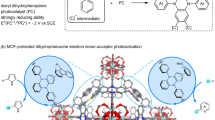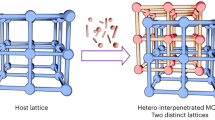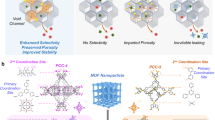Abstract
Metal–organic frameworks, built by bridging metal ions with organic linkers, represent a new class of porous hybrid materials with attractive tunability in compositions, structures and functions. In particular, the mild conditions typically employed for their synthesis allow for the functionalization of their building blocks, and thus the rational design of novel materials. Here we demonstrate the systematic design of eight mesoporous chiral metal–organic frameworks, with the framework formula [LCu2(solvent)2] (where L is a chiral tetracarboxylate ligand derived from 1,1′-bi-2-naphthol), that have the same structures but channels of different sizes. Chiral Lewis acid catalysts were generated by postsynthesis functionalization with Ti(OiPr)4, and the resulting materials proved to be highly active asymmetric catalysts for diethylzinc and alkynylzinc additions, which converted aromatic aldehydes into chiral secondary alcohols. The enantioselectivities of these reactions can be modified by tuning the size of the channels, which alters the diffusion rates of the organic substrates.
This is a preview of subscription content, access via your institution
Access options
Subscribe to this journal
Receive 12 print issues and online access
$259.00 per year
only $21.58 per issue
Buy this article
- Purchase on Springer Link
- Instant access to full article PDF
Prices may be subject to local taxes which are calculated during checkout






Similar content being viewed by others
References
Rowsell, J. L. C. & Yaghi, O. M. Strategies for hydrogen storage in metal–organic frameworks. Angew. Chem. Int. Ed. 44, 4670–4679 (2005).
Dinca, M. & Long, J. R. Hydrogen storage in microporous metal–organic frameworks with exposed metal sites. Angew. Chem. Int. Ed. 47, 6766–6779 (2008).
Matsuda, R. et al. Highly controlled acetylene accommodation in a metal–organic microporous material. Nature 436, 238–241 (2005).
Chen, B. et al. A luminescent metal–organic framework with Lewis basic pyridyl sites for the sensing of metal ions. Angew. Chem. Int. Ed. 48, 500–503 (2009).
Allendorf, M. D. et al. Stress-induced chemical detection using flexible metal–organic frameworks. J. Am. Chem. Soc. 130, 14404–14405 (2008).
Lan, A. J. et al. A luminescent microporous metal–organic framework for the fast and reversible detection of high explosives. Angew. Chem. Int. Ed. 48, 2334–2338 (2009).
Lin, W. Metal–organic frameworks for asymmetric catalysis and chiral separations. MRS Bull. 32, 544–548 (2007).
Lee, J. et al. Metal–organic framework materials as catalysts. Chem. Soc. Rev. 38, 1450–1459 (2009).
Ma, L., Abney, C. & Lin, W. Enantioselective catalysis with homochiral metal–organic frameworks. Chem. Soc. Rev. 38, 1248–1256 (2009).
Rieter, W. J., Taylor, K. M. L., An, H. Y., Lin, W. L. & Lin, W. Nanoscale metal–organic frameworks as potential multimodal contrast enhancing agents. J. Am. Chem. Soc. 128, 9024–9025 (2006).
Taylor, K. M. L., Jin, A. & Lin, W. Surfactant-assisted synthesis of nanoscale gadolinium metal–organic frameworks for potential multimodal imaging. Angew. Chem. Int. Ed. 47, 7722–7725 (2008).
Taylor, K. M. L., Rieter, W. J. & Lin, W. Manganese-based nanoscale metal–organic frameworks for magnetic resonance imaging. J. Am. Chem. Soc. 130, 14358–14359 (2008).
Horcajada, P. et al. Flexible porous metal–organic frameworks for a controlled drug delivery. J. Am. Chem. Soc. 130, 6774–6780 (2008).
Rieter, W. J., Pott, K. M., Taylor, K. M. L. & Lin, W. Nanoscale coordination polymers for platinum-based anticancer drug delivery. J. Am. Chem. Soc. 130, 11584–11585 (2008).
Zhao, X. B. et al. Hysteretic adsorption and desorption of hydrogen by nanoporous metal–organic frameworks. Science 306, 1012–1015 (2004).
Chen, B. et al. Surface interactions and quantum kinetic molecular sieving for H-2 and D-2 adsorption on a mixed metal–organic framework material. J. Am. Chem. Soc. 130, 6411–6423 (2008).
Chae, H. K. et al. A route to high surface area, porosity and inclusion of large molecules in crystals. Nature 427, 523–527 (2004).
Ferey, G. et al. A chromium terephthalate-based solid with unusually large pore volumes and surface area. Science 309, 2040–2042 (2005).
Koh, K., Wong-Foy, A. G. & Matzger, A. J. A crystalline mesoporous coordination copolymer with high microporosity. Angew. Chem. Int. Ed. 47, 677–680 (2008).
Seo, J. S. et al. A homochiral metal–organic porous material for enantioselective separation and catalysis. Nature 404, 982–986 (2000).
Evans, O. R., Ngo, H. L. & Lin, W. Chiral porous solids based on lamellar lanthanide phosphonates. J. Am. Chem. Soc. 123, 10395–10396 (2001).
Wu, C.-D., Hu, A., Zhang, L. & Lin, W. Homochiral porous metal–organic framework for highly enantioselective heterogeneous asymmetric catalysis. J. Am. Chem. Soc. 127, 8940–8941 (2005).
Cho, S. H., Ma, B. Q., Nguyen, S. T., Hupp, J. T. & Albrecht-Schmitt, T. E. A metal–organic framework material that functions as an enantioselective catalyst for olefin epoxidation. Chem. Commun. 2563–2565 (2006).
Wu, C.-D. & Lin, W. Heterogeneous asymmetric catalysis with homochiral metal–organic frameworks: network-structure-dependent catalytic activity. Angew. Chem. Int. Ed. 46, 1075–1078 (2007).
Banerjee, M. et al. Postsynthetic modification switches an achiral framework to catalytically active homochiral metal–organic porous materials. J. Am. Chem. Soc. 131, 7524–7525 (2009).
Lin, X. et al. High H2 adsorption by coordination-framework materials. Angew. Chem. Int. Ed. 45, 7358–7364 (2006).
Ma, L., Lee, J. Y., Li, J. & Lin, W. 3D metal–organic frameworks based on elongated tetracarboxylate building blocks for hydrogen storage. Inorg. Chem. 47, 3955–3957 (2008).
Wu, S., Ma, L., Long, L., Zheng, L. & Lin, W. Three-dimensional metal–organic frameworks based on functionalized tetracarboxylate linkers: synthesis, structures, and gas sorption. Inorg. Chem. 48, 2436–2442 (2009).
Ma, L. & Lin, W. Chirality-controlled and solvent-templated catenation isomerism in metal–organic frameworks. J. Am. Chem. Soc. 130, 13834–13835 (2008).
Lin, X. et al. High capacity hydrogen adsorption in Cu(II) tetracarboxylate framework materials: the role of pore size, ligand functionalization, and exposed metal sites. J. Am. Chem. Soc. 131, 2159–2171 (2009).
Spek, A. L. Single-crystal structure validation with the program PLATON. J. Appl. Crystallogr. 36, 7–13 (2003).
Kiang, Y. H., Gardner, G. B., Lee, S., Xu, Z. T. & Lobkovsky, E. B. Variable pore size, variable chemical functionality, and an example of reactivity within porous phenylacetylene silver salts. J. Am. Chem. Soc. 121, 8204–8215 (1999).
Wang, Z. Q. & Cohen, S. M. Postsynthetic covalent modification of a neutral metal–organic framework. J. Am. Chem. Soc. 129, 12368–12369 (2007).
Wang, Z. Q. & Cohen, S. M. Postsynthetic modification of metal–organic frameworks. Chem. Soc. Rev. 38, 1315–1329 (2009).
Eddaoudi, M. et al. Systematic design of pore size and functionality in isoreticular MOFs and their application in methane storage. Science 295, 469–472 (2002).
Evans, O. R. & Lin, W. Crystal engineering of NLO materials based on metal–organic coordination networks. Acc. Chem. Res. 35, 511–522 (2002).
Yaghi, O. M. et al. Reticular synthesis and the design of new materials. Nature 423, 705–714 (2003).
Chui, S. S. Y., Lo, S. M. F., Charmant, J. P. H., Orpen, A. G. & Williams, I. D. A chemically functionalizable nanoporous material [Cu3(TMA)2(H2O)3]n . Science 283, 1148–1150 (1999).
Farha, O. K., Mulfort, K. L. & Hupp, J. T. An example of node-based postassembly elaboration of a hydrogen-sorbing, metal–organic framework material. Inorg. Chem. 47, 10223–10225 (2008).
Ma, L., Xie, Z., Jin, A. & Lin, W. Freeze drying significantly increases permanent porosity and hydrogen uptake in 4,4-connected metal–organic frameworks. Angew. Chem. Int. Ed. 48, 9905–9908 (2009).
Walton, K. S. & Snurr, R. Q. Applicability of the BET method for determining surface areas of microporous metal–organic frameworks. J. Am. Chem. Soc. 129, 8552–8556 (2007).
Serre, C. et al. Role of solvent–host interactions that lead to very large swelling of hybrid frameworks. Science 315, 1828–1831 (2007).
Llewellyn, P. L. et al. Prediction of the conditions for breathing of metal organic framework materials using a combination of X-ray powder diffraction, microcalorimetry, and molecular simulation. J. Am. Chem. Soc. 130, 12808–12814 (2008).
Nelson, A. P., Farha, O. K., Mulfort, K. L. & Hupp, J. T. Supercritical processing as a route to high internal surface areas and permanent microporosity in metal–organic framework materials. J. Am. Chem. Soc. 131, 458–460 (2009).
Pu, L. & Yu, H. B. Catalytic asymmetric organozinc additions to carbonyl compounds. Chem. Rev. 101, 757–824 (2001).
Acknowledgements
We thank the National Science Foundation (CHE-0512495 and -0809776) for generous support of this research and R. Huxford for experimental help.
Author information
Authors and Affiliations
Contributions
L.M., J.M.F., C.A. and W.L. designed and conducted the research. L.M., J.M.F. and W.L. co-wrote the paper.
Corresponding author
Ethics declarations
Competing interests
The authors declare no competing financial interests.
Supplementary information
Supplementary information
Supplementary information (PDF 2307 kb)
Supplementary information
Crystallographic data for compound CMOF-1a (CIF 13 kb)
Supplementary information
Crystallographic data for compound CMOF-2a (CIF 13 kb)
Supplementary information
Crystallographic data for compound CMOF-2b (CIF 12 kb)
Supplementary information
Crystallographic data for compound CMOF-3b (CIF 14 kb)
Supplementary information
Crystallographic data for compound CMOF-4a (CIF 15 kb)
Supplementary information
Crystallographic data for compound CMOF-4b (CIF 15 kb)
Rights and permissions
About this article
Cite this article
Ma, L., Falkowski, J., Abney, C. et al. A series of isoreticular chiral metal–organic frameworks as a tunable platform for asymmetric catalysis. Nature Chem 2, 838–846 (2010). https://doi.org/10.1038/nchem.738
Received:
Accepted:
Published:
Issue Date:
DOI: https://doi.org/10.1038/nchem.738
This article is cited by
-
Chemically routed interpore molecular diffusion in metal-organic framework thin films
Nature Communications (2023)
-
Chiroluminophores based on non-conjugated benzenes
Science China Chemistry (2023)
-
Tunable chiroptical application by encapsulating achiral lanthanide complexes into chiral MOF thin films
Nano Research (2022)
-
Synthesis, Structure, and Properties of a Dinuclear Cu(II) Coordination Polymer Based on Quinoxaline and 3,3-Thiodipropionic Acid Ligands
Journal of Inorganic and Organometallic Polymers and Materials (2021)
-
Chiral metal-organic frameworks with tunable catalytic selectivity in asymmetric transfer hydrogenation reactions
Nano Research (2021)



